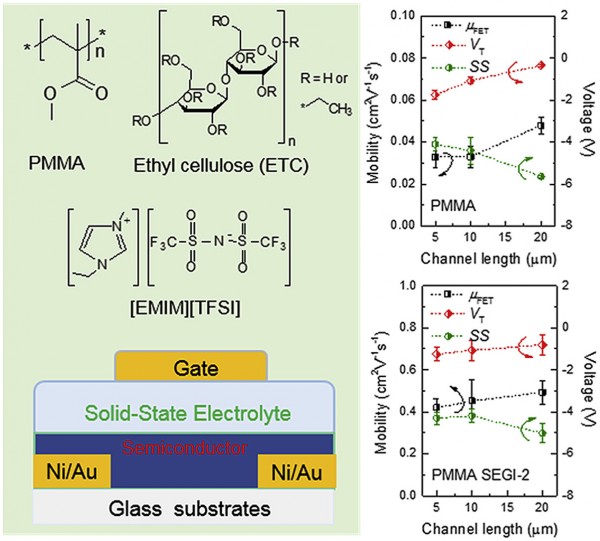Exploring low-k dielectrics as structuring polymers for solid-state electrolyte-gated transistors
- 저자
- Benjamin Nketia-Yawson*, Grace Dansoa Tabi, Stephen Boandoh, Jea Woong Jo, Yong-Young Noh*
- 저널명
- Organic Electronics, 75, 105434 (2019)
- 년도
- 2019
- Link
- https://doi.org/10.1016/j.orgel.2019.105434 164회 연결
[Abstract]
In this paper, we report the effect of using low-k polymer dielectrics as structuring polymers to prepare solid-state electrolyte insulators (SEGIs) for organic field-effect transistors (OFETs). Here, we use poly(3-hexylthiophene-2,5-diyl) (P3HT) as a semiconductor and explore poly(methyl methacrylate) (PMMA) and ethyl cellulose (ETC) polymer dielectrics as bulk structuring polymers for forming the SEGIs. Among the structuring polymers, PMMA-based SEGIs show favorable blend miscibility, exhibiting capacitance values of 20.61 ± 1.45 nFcm−2 at 1 Hz, whereas neat PMMA capacitors recorded 13.15 ± 0.55 nFcm−2. We achieve field-effect mobilities of 0.49 ± 0.06 and 0.05 ± 0.01 cm2 V−1s−1 in PMMA SEGI-2 and neat PMMA OFETs, respectively, operating at 10 V. The OFETs based on the PMMA SEGIs exhibit a relatively smaller hysteresis as compared to that of the ETC SEGI-gated OFETs. A comprehensive analysis of the PMMA SEGI devices using the transfer line method show a reduced contact resistance close to two orders of magnitude compared to that of the neat PMMA OFETs. This study provides a significant insight into the development of high-performance solid-state electrolyte-gated transistors by the selection and consideration of appropriate structuring polymers.
